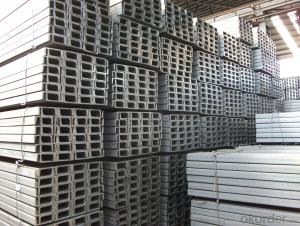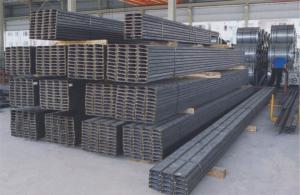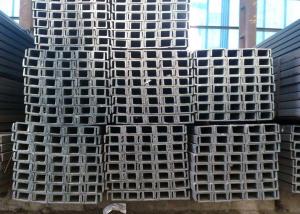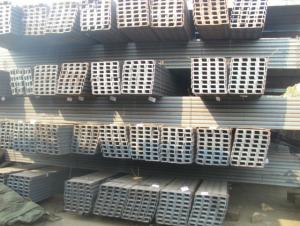S235JR S355JR SS400 A36 Q235 Q345 Hot Rolled Steel Channel Steel /C Channel Steel / U Channel Steel
- Loading Port:
- Tianjin
- Payment Terms:
- TT OR LC
- Min Order Qty:
- 25 m.t.
- Supply Capability:
- 32000 m.t./month
OKorder Service Pledge
OKorder Financial Service
You Might Also Like
Specifications
41*41 steel u slotted channel
Standard: 41x41, 41X21
Thickness: 1.5mm-3mm
zinc plated ,powder coated ,HDG,SS304
slotted
S235JR S355JR SS400 A36 Q235 Q345 Hot Rolled Steel Channel Steel /C Channel Steel / U Channel Steel
1.Standard:Standard: 41x41, 41X21
2.Wall thickness: 1.5mm, 1.6mm, 2.0mm, 2.5mm, 2.7mm (can produce based on your requirement).
3.Length: 3m, 5.8m, 6m .Any length is possible.
4.Surface Treatment: Pre-galvanized or hot-dip galvanized,Powder Coated.
5.Type: Slotted & Plained. Several slot size for you to choose
6.We can make back to back channel.
7.Many connecting sheets to connect two or several strut channels




- Q: What is the typical lifespan of steel channels?
- The typical lifespan of steel channels can vary depending on various factors such as the quality of the steel, environmental conditions, and maintenance practices. However, with proper care and maintenance, steel channels can have a lifespan of several decades or even longer.
- Q: Can steel channels be used for machinery framing?
- Indeed, machinery framing can make use of steel channels. Given their robustness and resilience, steel channels are frequently employed across the construction and manufacturing sectors. They furnish a sturdy and inflexible framework capable of sustaining heavy machinery and equipment. Thanks to their exceptional structural support, steel channels prove themselves ideal for machinery framing purposes. Moreover, they can be effortlessly personalized and manufactured to satisfy precise design needs, guaranteeing an exact fit and optimal performance for machinery framing endeavors.
- Q: Are steel channels suitable for use in the construction of signage structures?
- Yes, steel channels are suitable for use in the construction of signage structures. Steel channels are versatile and durable, making them an ideal choice for creating strong and sturdy signage structures. They can support heavy loads and withstand harsh weather conditions, making them suitable for outdoor signage. Steel channels also provide excellent structural support, allowing for the creation of large and intricate signage designs. Additionally, they can be easily fabricated and customized to meet specific design requirements. Overall, steel channels offer a reliable and long-lasting solution for constructing signage structures.
- Q: How do steel channels perform in terms of wind resistance?
- Steel channels perform very well in terms of wind resistance. Their structural design and material strength allow them to withstand high wind loads without significant deformation or failure. This makes steel channels a reliable choice for applications where wind resistance is a critical factor, such as in the construction of high-rise buildings, bridges, or wind turbine towers.
- Q: No. 20 b one meter with multiple channel
- GB/T 706-2008 "hot rolled steel" No. 20 B channel 25.777kg/m.
- Q: If there is a cylinder, the diameter is about 1000mm, height is about 1000mm, similar to the kind of pressure vessel, plate thickness 6mm 304 of stainless steel, want to use 4 channel steel leg support, how big is appropriate? How do you calculate it?
- What's in the pressure vessel?Calculate the weight, each channel bear 1/4, calculate the required area of A=N/p, and then channel selection.Very simple buddy.
- Q: Can steel channels be used in solar panel installations?
- Yes, steel channels can be used in solar panel installations. Steel channels, also known as steel C channels or steel U channels, are commonly used in construction and industrial applications for their strength, durability, and versatility. When it comes to solar panel installations, steel channels can be used as support structures for mounting solar panels on rooftops or in ground-mounted systems. Steel channels provide a stable and robust framework that can withstand the weight of solar panels and withstand various weather conditions. They can be easily customized and fabricated to meet specific installation requirements, such as the size and angle of the solar panels. Additionally, steel channels can be galvanized or coated to provide corrosion resistance, ensuring the longevity of the solar panel installation. Furthermore, steel channels offer flexibility in terms of design and layout. They can be easily integrated with other mounting systems and components, such as rails, brackets, and clamps, allowing for efficient and secure solar panel installations. The adaptability of steel channels makes them suitable for both residential and commercial solar panel projects. In conclusion, steel channels are a viable option for solar panel installations due to their strength, durability, versatility, and compatibility with other mounting systems. They provide a solid foundation for mounting solar panels, ensuring a stable and efficient solar energy system.
- Q: Can steel channels be used in railway infrastructure projects?
- Certainly! Steel channels have a significant role to play in railway infrastructure projects. They find widespread use in the construction and maintenance of railway tracks, bridges, and other structures. Their inherent strength, stability, and durability make them ideal for bearing heavy loads and enduring the continuous movement and vibrations associated with railway operations. In the realm of railway infrastructure, steel channels serve multiple purposes, such as providing support for the rails, fabricating track sleepers, reinforcing bridges and tunnels, and erecting safety barriers and fencing. Moreover, steel channels can be tailored to meet specific project requirements in terms of size, shape, and material composition, thereby further augmenting their suitability for railway infrastructure projects.
- Q: Can steel channels be used for solar panel mounting systems?
- Yes, steel channels can be used for solar panel mounting systems. Steel channels provide a sturdy and durable framework for mounting solar panels. They are able to withstand the weight of the panels and provide a stable base for installation. Additionally, steel channels can be easily customized and adjusted to fit specific project requirements, making them a versatile option for solar panel mounting systems. The strength and rigidity of steel channels also ensure that the solar panels are securely held in place, even in harsh weather conditions. Overall, steel channels are a popular choice for solar panel mounting systems due to their strength, durability, and versatility.
- Q: How do steel channels contribute to the overall material efficiency of a structure?
- Steel channels play a crucial role in enhancing the material efficiency of a structure. These structural elements are designed to provide strength and support to various structural components, optimizing the use of materials in a cost-effective manner. Firstly, steel channels are known for their high strength-to-weight ratio. This means that they can carry heavy loads while being relatively lightweight themselves. By utilizing steel channels, engineers can reduce the amount of material required to support the structure, resulting in a more efficient use of resources. This is particularly important in large-scale projects where reducing the overall weight of the structure can lead to significant cost savings. Moreover, steel channels offer versatility in terms of design and construction. Their uniform shape and standardized dimensions allow for easy integration into different structural systems. This reduces the need for custom fabrication and simplifies the construction process. As a result, the overall material efficiency of the structure is improved as there is minimal wastage of resources during the construction phase. Furthermore, steel channels contribute to the overall durability and longevity of the structure. Steel is known for its resistance to corrosion, fire, and other environmental factors. This ensures that the structure remains intact and functional for an extended period, reducing the need for frequent maintenance or replacement. By using steel channels, the overall lifecycle of the structure is increased, leading to improved material efficiency. In conclusion, steel channels play a vital role in enhancing the material efficiency of a structure. Their high strength-to-weight ratio, versatility in design, and durability contribute to reducing material usage, simplifying construction, and increasing the longevity of the structure. By incorporating steel channels into the structural design, engineers can optimize the use of materials, resulting in a more sustainable and cost-effective solution.
Send your message to us
S235JR S355JR SS400 A36 Q235 Q345 Hot Rolled Steel Channel Steel /C Channel Steel / U Channel Steel
- Loading Port:
- Tianjin
- Payment Terms:
- TT OR LC
- Min Order Qty:
- 25 m.t.
- Supply Capability:
- 32000 m.t./month
OKorder Service Pledge
OKorder Financial Service
Similar products
Hot products
Hot Searches
Related keywords




























